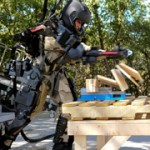Archive for Сентябрь, 2010
System for arm therapy
- Тип контента: Патент
- Номер документа: 4577
- Название документа: System for arm therapy
- Номер (DOI, IBSN, Патент): US2010/0249673A1
- Изобретатель/автор: Nef, T., Brunschweiler A., Reiner R., Schulz N.
- Правопреемник/учебное заведение: Eidgenössische Technische Hochschule, Zürich, Switzerland
- Дата публикации документа: 2010-09-30
- Страна опубликовавшая документ: США
- Язык документа: Английский
- Наименование изделия: Не заполнено
- Источник: http://www.google.com/patents/US20100249673
- Вложения: Да
- Аналитик: Дмитрий Соловьев
 A system for arm therapy comprises a first drive (M2) that can be fixedly connected to an element (10) determining the position of a user (19) and rotationally driving, about a first axis (A2), a part (21, 22, 23, 24, 25, M1, 26) of the arm therapy system which can be connected to an upper arm module (26, M3, M4). The driven part of the arm therapy system comprises a second drive (M1) adapted to rotationally drive said upper arm module (26, M3, M4) about a second axis (A1), wherein said second axis (A1) is oriented orthogonal to the first axis (A2). The system can provide a statically determined exoskeleton with correct anatomical axes and misaligned technical axes.
A system for arm therapy comprises a first drive (M2) that can be fixedly connected to an element (10) determining the position of a user (19) and rotationally driving, about a first axis (A2), a part (21, 22, 23, 24, 25, M1, 26) of the arm therapy system which can be connected to an upper arm module (26, M3, M4). The driven part of the arm therapy system comprises a second drive (M1) adapted to rotationally drive said upper arm module (26, M3, M4) about a second axis (A1), wherein said second axis (A1) is oriented orthogonal to the first axis (A2). The system can provide a statically determined exoskeleton with correct anatomical axes and misaligned technical axes.
Категория: Патенты | Нет комментариев »
Modeling of Transmission Characteristics Across a Cable-Conduit System
- Тип контента: Научная статья
- Номер документа: 1589
- Название документа: Modeling of Transmission Characteristics Across a Cable-Conduit System
- Номер (DOI, IBSN, Патент): 10.1109/TRO.2010.2064014
- Изобретатель/автор: Peine, W.J., Bin Yao, Agrawal, V.
- Правопреемник/учебное заведение: Sch. of Mech. Eng., Purdue Univ., West Lafayette, IN, USA
- Дата публикации документа: 2010-09-30
- Страна опубликовавшая документ: США
- Язык документа: Английский
- Наименование изделия: Не заполнено
- Источник: http://ieeexplore.ieee.org/search/freesrchabstract.jsp?tp=&a
- Вложения: Да
- Аналитик: Дмитрий Соловьев
 Many robotic systems, like surgical robots, robotic hands, and exoskeleton robots, use cable passing through conduits to actuate remote instruments. Cable actuation simplifies the design and allows the actuator to be located at a convenient location, away from the end effector. However, nonlinear frictions between the cable and the conduit account for major losses in tension transmission across the cable, and a model is needed to characterize their effects in order to analyze and compensate for them. Although some models have been proposed in the literature, they are lumped parameter based and restricted to the very special case of a single cable with constant conduit curvature and constant pretension across the cable only. This paper proposes a mathematically rigorous distributed parameter model for cable-conduit actuation with any curvature and initial tension profile across the cable. The model, which is described by a set of partial differential equations in the continuous time-domain, is also discretized for the effective numerical simulation of the cable motion and tension transmission across the cable. Unlike the existing lumped-parameter-based models, the resultant discretized model enables one to accurately simulate the partial-moving/partial-sticking cable motion of the cable-conduit actuation with any curvature and initial tension profile. The model is further extended to cable-conduit actuation in pull-pull configuration using a pair of cables. Various simulations results are presented to reveal the unique phenomena like backlash, cable slacking, interaction between the two cables, and other nonlinear behaviors associated with the cable conduits in pull-pull configuration. These results are verified by experiments using two dc motors coupled with a cable-conduit pair. The experimental setup has been prepared to emulate a typical cable-actuated robotic system. Experimental results are compared with the simulations and various implications are discussed.
Many robotic systems, like surgical robots, robotic hands, and exoskeleton robots, use cable passing through conduits to actuate remote instruments. Cable actuation simplifies the design and allows the actuator to be located at a convenient location, away from the end effector. However, nonlinear frictions between the cable and the conduit account for major losses in tension transmission across the cable, and a model is needed to characterize their effects in order to analyze and compensate for them. Although some models have been proposed in the literature, they are lumped parameter based and restricted to the very special case of a single cable with constant conduit curvature and constant pretension across the cable only. This paper proposes a mathematically rigorous distributed parameter model for cable-conduit actuation with any curvature and initial tension profile across the cable. The model, which is described by a set of partial differential equations in the continuous time-domain, is also discretized for the effective numerical simulation of the cable motion and tension transmission across the cable. Unlike the existing lumped-parameter-based models, the resultant discretized model enables one to accurately simulate the partial-moving/partial-sticking cable motion of the cable-conduit actuation with any curvature and initial tension profile. The model is further extended to cable-conduit actuation in pull-pull configuration using a pair of cables. Various simulations results are presented to reveal the unique phenomena like backlash, cable slacking, interaction between the two cables, and other nonlinear behaviors associated with the cable conduits in pull-pull configuration. These results are verified by experiments using two dc motors coupled with a cable-conduit pair. The experimental setup has been prepared to emulate a typical cable-actuated robotic system. Experimental results are compared with the simulations and various implications are discussed.
Категория: Научные статьи | Нет комментариев »
Оборонщики США создали второго Железного человека
- Тип контента: Новостная статья, Видео
- Номер документа: 2186
- Название документа: Оборонщики США создали второго Железного человека
- Номер (DOI, IBSN, Патент): Не заполнено
- Изобретатель/автор: Не заполнено
- Правопреемник/учебное заведение: Не заполнено
- Дата публикации документа: 2010-09-30
- Страна опубликовавшая документ: Россия
- Язык документа: Русский
- Наименование изделия: Не заполнено
- Источник: http://www.membrana.ru/particle/3405
- Вложения: Не заполнено
- Аналитик: Ридна Украина)))
 Новый костюм позволяет своему хозяину переносить в руках или на себе десятки килограммов груза без видимых усилий и разбивать рукой четыре сложенные вместе деревянные доски. Последнее, конечно, показное лихачество — в рукопашный бой никто в таком облачении ещё не собирается. Но инженеры, создавшие мощный экзоскелет, планирует со временем привнести эту новинку в армию.
Новый костюм позволяет своему хозяину переносить в руках или на себе десятки килограммов груза без видимых усилий и разбивать рукой четыре сложенные вместе деревянные доски. Последнее, конечно, показное лихачество — в рукопашный бой никто в таком облачении ещё не собирается. Но инженеры, создавшие мощный экзоскелет, планирует со временем привнести эту новинку в армию.
Категория: XOS 2 | 6 комментариев »
Development of a Myoelectric Joystick: a Preliminary Study
- Тип контента: Научная статья
- Номер документа: 6495
- Название документа: Development of a Myoelectric Joystick: a Preliminary Study
- Номер (DOI, IBSN, Патент): Не заполнено
- Изобретатель/автор: Changmok Choi, Jung Kim
- Правопреемник/учебное заведение: The University of Tokyo
- Дата публикации документа: 2010-09-29
- Страна опубликовавшая документ: Япония
- Язык документа: Английский
- Наименование изделия: Не заполнено
- Источник: Proceedings of the 2010 3rd IEEE RAS & EMBS
- Вложения: Да
- Аналитик: Глаголева Елена
 Current manual joysticks have been widely used to con-trol various artificial devices, but they are expensive and composed of mechanically bulky frames. To ad-dress these issues, we developed a myoelectric joystick using surface electromyogram (sEMG) from six mus-cles that make a wrist joint move. Fluid wrist movements were estimated by introducing a non-negative mus-cle synergy matrix and a joint synergy matrix. Only four movements were predefined (wrist extension, wrist flexion, radial deviation, and ulnar deviation) to construct the muscle synergy matrix, but an experimen-tal result showed that a variety of movements (e.g., a combination of wrist extension and ulnar deviation) could be extracted using the joint matrix. This work also could be extended for development of an alterna-tive computer interface and powered wrist prosthesis for individuals with transradial or wrist disarticu-lation level amputation.
Current manual joysticks have been widely used to con-trol various artificial devices, but they are expensive and composed of mechanically bulky frames. To ad-dress these issues, we developed a myoelectric joystick using surface electromyogram (sEMG) from six mus-cles that make a wrist joint move. Fluid wrist movements were estimated by introducing a non-negative mus-cle synergy matrix and a joint synergy matrix. Only four movements were predefined (wrist extension, wrist flexion, radial deviation, and ulnar deviation) to construct the muscle synergy matrix, but an experimen-tal result showed that a variety of movements (e.g., a combination of wrist extension and ulnar deviation) could be extracted using the joint matrix. This work also could be extended for development of an alterna-tive computer interface and powered wrist prosthesis for individuals with transradial or wrist disarticu-lation level amputation.
Категория: Научные статьи | Нет комментариев »
A stiff tendon neuromusculoskeletal model of the knee
- Тип контента: Научная статья
- Номер документа: 1661
- Название документа: A stiff tendon neuromusculoskeletal model of the knee
- Номер (DOI, IBSN, Патент): 10.1109/ARSO.2009.5587058
- Изобретатель/автор: Sartori, M., Reggiani, M., Pagello, E., Lloyd, D.G.
- Правопреемник/учебное заведение: Dept. of Inf. Eng., Univ. of Padova, Padova, Italy
- Дата публикации документа: 2010-09-27
- Страна опубликовавшая документ: Италия
- Язык документа: Английский
- Наименование изделия: Не заполнено
- Источник: http://ieeexplore.ieee.org/search/freesrchabstract.jsp?tp=&a
- Вложения: Да
- Аналитик: Дмитрий Соловьев
 Now more than ever, progresses in information technology applied to rehabilitation robotics give new hopes to people recovering from different kinds of diseases and injuries. Beside the standard application of EMG signals to analyze disabilities or to track progress in rehabilitation, more focus has been put on controlling robot arms and exoskeletons. In recent years, biomechanists have developed very complex neuromusculoskeletal (NM) models of human joints to understand how the nervous system controls muscles and generates movements. Aware of these potentials, we have started a process of simplification to obtain a NM model suitable for the real-time control for a lower extremity exoskeleton. In this paper we present the NM model for the knee previously developed by Lloyd et al. We then investigate the effects of assuming the tendon infinitely stiff and show how this simplification does not affect the capacity of the model to predict muscle force and joint moment. We also assess the decrease in processing time required to calibrate the model and perform runtime estimates of muscles. Finally, we illustrate the implications of our research for the health care economic and social systems.
Now more than ever, progresses in information technology applied to rehabilitation robotics give new hopes to people recovering from different kinds of diseases and injuries. Beside the standard application of EMG signals to analyze disabilities or to track progress in rehabilitation, more focus has been put on controlling robot arms and exoskeletons. In recent years, biomechanists have developed very complex neuromusculoskeletal (NM) models of human joints to understand how the nervous system controls muscles and generates movements. Aware of these potentials, we have started a process of simplification to obtain a NM model suitable for the real-time control for a lower extremity exoskeleton. In this paper we present the NM model for the knee previously developed by Lloyd et al. We then investigate the effects of assuming the tendon infinitely stiff and show how this simplification does not affect the capacity of the model to predict muscle force and joint moment. We also assess the decrease in processing time required to calibrate the model and perform runtime estimates of muscles. Finally, we illustrate the implications of our research for the health care economic and social systems.
Категория: Научные статьи | Нет комментариев »
Статистика
Категорий: 179
Статей всего: 2,003
По типу:
Видео: 36
Выдержка с форума: 1
Контактные данные: 12
Научная статья: 1388
Не заполнено: 5
Новостная статья: 317
Обзор технологии: 42
Патент: 219
Тех.подробности: 34
Тип: 1
Комментариев: 9,470
Изображений: 3,005
Подробней...
ТОР 10 аналитиков
-
Глаголева Елена - 591
Дмитрий Соловьев - 459
Helix - 218
Ридна Украина))) - 85
Наталья Черкасова - 81
max-orduan - 29
Елена Токай - 15
Роман Михайлов - 9
Мансур Жигануров - 4
Дуванова Татьяна - 3
Календарь
Авторизация
Ошибка в тексте?
Выдели её мышкой!
И нажми Ctrl+Enter